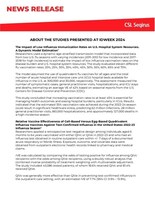CSL Seqirus Presents Data at IDWeek 2024 Highlighting the Urgent Need to Increase Influenza Vaccination Rates and the Benefits of Cell-Based Influenza Vaccines
Werte in diesem Artikel
- Analysis from a dynamic model showed the need to increase influenza vaccination rates in the U.S. to at least 45% to avoid saturation of hospital system resources, particularly in intensive care units (ICUs).1
- Results from multiple real-world evidence (RWE) studies over different seasons showed improved relative vaccine effectiveness (rVE) of cell-based vaccines compared with egg-based vaccines in preventing outpatient test-confirmed influenza across different age groups, including as young as 6 months.2,3
- A model based on RWE from the 2022-23 flu season study estimated that the use of a cell-based influenza vaccine would have averted a significant burden of influenza-related illnesses compared to an egg-based influenza vaccine.4
SUMMIT, N.J., Oct. 16, 2024 /PRNewswire/ -- CSL Seqirus, a business of CSL (ASX: CSL), today announced new data from five studies reinforcing the importance of seasonal influenza vaccination and exhibiting the benefits of cell-based influenza vaccines among people aged 6 months to 64 years. These studies will be presented this week at the IDWeek 2024 conference taking place in Los Angeles, California from October 16-19, 2024.
For several flu seasons, influenza vaccination rates in the U.S. have been in decline.5,6 A dynamic model assessed eleven possible influenza vaccination rates, ranging from 20% to 70%, using data from two U.S. flu seasons (2011-2012 for low incidence and 2017-2018 for high incidence). An average vaccine effectiveness rate (VE) of 42% was used in the analysis, based on seasonal reports from the U.S. Centers for Disease Control and Prevention (CDC).1 Findings indicated that lower vaccination rates, such as the 2023-24 season rate of ≈35%, would put considerable pressure on the U.S. hospital system.1,7 In contrast, increasing the overall vaccination rate to at least 45% is needed to avoid the saturation of hospital resources, especially intensive care unit (ICU) hospital beds.1
"Evidence shows that higher influenza vaccination rates significantly reduce serious health consequences, including severe illness, hospitalizations, and death. These data underscore an urgent call to action to increase vaccination rates to at least 45% to avoid overburdening our health systems and ensure that our hospital resources, especially ICU beds, are not overwhelmed," said Joaquin Mould-Quevedo, Global Health Economic and Value Strategy Senior Director at CSL Seqirus. "At CSL Seqirus, we are committed to partnering with the healthcare community to reverse the decline in influenza vaccination rates and improve public health. We are proud to use the interactive dynamic model from this study to inform and support healthcare providers in their vaccination efforts."
Other studies being presented by CSL Seqirus at IDWeek include:
- Results from a retrospective test-negative design study of the 2022/23 season in the U.S. showed that cell-based quadrivalent (QIVc) vaccines prevented more outpatient test-confirmed influenza for those aged six months to 64 years compared with the egg-based quadrivalent (QIVe) vaccines.2
- Results from a systematic literature review of reported effectiveness during the 2017 to 2020 influenza seasons revealed a higher relative effectiveness of QIVc over QIVe/egg-based trivalent (TIVe) vaccines for those aged 4 to 64 years across the three influenza seasons for both test-confirmed influenza and clinically diagnosed influenza.3
- Results from a model study of the 2022/23 season in the U.S. estimated that a cell-based inactivated quadrivalent influenza vaccine (ccIIV4) would have averted a significant burden of influenza-related illnesses for those aged 0 to 64 years compared to an egg-based inactivated quadrivalent influenza vaccine (IIV4).4
- Results from a dynamic model study of the 2018 to 2020 influenza seasons in the U.S., calibrated with data from the CDC and published U.S. observational studies, indicated that QIVc was cost saving compared to the recombinant influenza vaccine (QIVr) for those aged 18 to 64 years and achieved comparable health outcomes results at a significant reduction in cost.8
These studies add to the growing body of evidence showcasing the benefits of cell-based influenza vaccines compared to standard-dose egg-based influenza vaccines, including the prevention of influenza infections and related complications.2,3,4,8 Moreover, the use of cell-based vaccines was estimated to be associated with substantial economic savings due to lower healthcare utilization and reduced direct medical costs.8
"The results from these studies, collected and analyzed over several recent influenza seasons, have shown that cell-based influenza vaccines are effective in preventing both test-confirmed and clinically diagnosed influenza," stated Mendel Haag, Senior Director, Center of Outcomes Research & Epidemiology at CSL Seqirus. "Data presented at this year's IDWeek further reinforce the importance of protecting people against influenza, particularly in our more vulnerable populations, including children as young as six months. This real-world evidence underscores the critical role of cell-based influenza vaccines in improving public health outcomes and easing the burden on healthcare systems during flu seasons."
For more information about the data being presented at IDWeek 2024, refer to the related document.
Study Limitations
The above studies featuring RWE were subject to the typical limitations associated with retrospective cohort analyses. Unmeasured and residual confounding remain a potential source of bias as in all observational research. Additionally, vaccination in these observational studies was not randomly assigned.
As with all simulations, analyses based on models have several limitations based on a model's parameters and available data, as well as annually varying vaccine effectiveness. Modeling may underestimate the true number of cases averted for several reasons and studies may not account for the indirect benefits of vaccination or capture potential variability between sub-groups.
About Seasonal Influenza
Influenza is a common, contagious seasonal respiratory disease that may cause severe illness and life-threatening complications in some people.9 Influenza can lead to clinical symptoms varying from mild to moderate respiratory illness to severe complications, hospitalization and in some cases, death.9 Because transmission of influenza viruses to others may occur one day before symptoms develop and up to 5 to 7 days after becoming sick, the disease can be easily transmitted to others.9 Preliminary estimates from the Centers for Disease Control and Prevention (CDC) report that during the 2023/24 influenza season, there were an estimated 390,000-830,000 influenza-related hospitalizations in the U.S.10 The CDC recommends annual vaccination for people aged six months and older, who do not have any contraindications.11 Since it takes about two weeks after vaccination for antibodies to develop in the body that help protect against influenza virus infection, it is recommended that people get vaccinated before influenza begins spreading in their community.11 The CDC recommends that for most people who need only 1 dose of flu vaccine, vaccination should ideally happen in September or October.11
About CSL Seqirus
CSL Seqirus is part of CSL (ASX: CSL). As a global leader in the protection of public health and one of the largest influenza vaccine providers in the world, CSL Seqirus is committed to preventing infectious diseases, like influenza and COVID-19, and is a transcontinental partner in pandemic preparedness. With state-of-the-art production facilities in the U.S., the U.K. and Australia, and leading R&D capabilities, CSL Seqirus offers a broad portfolio of innovative, differentiated vaccines in more than 20 countries around the world.
For more information about CSL Seqirus, visit www.CSL.com.
About CSL
CSL (ASX:CSL; USOTC:CSLLY) is a global biotechnology company with a dynamic portfolio of lifesaving medicines, including those that treat haemophilia and immune deficiencies, vaccines to prevent influenza, and therapies in iron deficiency and nephrology. Since our start in 1916, we have been driven by our promise to save lives using the latest technologies. Today, CSL – including our three businesses: CSL Behring, CSL Seqirus and CSL Vifor – provides lifesaving products to patients in more than 100 countries and employs 32,000 people. Our unique combination of commercial strength, R&D focus and operational excellence enables us to identify, develop and deliver innovations so our patients can live life to the fullest. For inspiring stories about the promise of biotechnology, visit CSLBehring.com/Vita and follow us on Twitter.com/CSL.
For more information about CSL, visit www.CSL.com.
Intended Audience
This press release is issued from CSL Seqirus in Summit, New Jersey, USA and is intended to provide information about our global business. Please be aware that information relating to the approval status and labels of approved CSL Seqirus products may vary from country to country. Please consult your local regulatory authority on the approval status of CSL Seqirus products.
Forward-Looking Statements
This press release may contain forward-looking statements, including statements regarding future results, performance or achievements. These statements involve known and unknown risks, uncertainties and other factors which may cause our actual results, performance or achievements to be materially different from any future results, performances or achievements expressed or implied by the forward-looking statements. These statements reflect our current views with respect to future events and are based on assumptions and subject to risks and uncertainties. Given these uncertainties, you should not place undue reliance on these forward-looking statements.
FLUCELVAX® (Influenza Vaccine) IMPORTANT SAFETY INFORMATION
What is FLUCELVAX® (Influenza Vaccine)?
FLUCELVAX is a vaccine that helps protect people aged 6 months and older from the flu. Vaccination with FLUCELVAX may not protect all people who receive the vaccine.
Who should not receive FLUCELVAX?
You should not receive FLUCELVAX if you have a history of severe allergic reactions (e.g., anaphylaxis) to any component of the vaccine.
Before receiving FLUCELVAX, tell your healthcare provider about all medical conditions, including if you:
- have ever had Guillain-Barré syndrome (severe muscle weakness) within six weeks after getting a flu vaccine. The decision to give FLUCELVAX should be made by your healthcare provider, based on careful consideration of the potential benefits and risks.
- have problems with your immune system or are taking certain medications that suppress your immune system, as these may reduce your immune response to the vaccine
- have ever fainted when receiving a vaccine
What are the most common side effects of FLUCELVAX?
- pain and/or redness where the vaccine was given
- headache
- extreme tiredness
- muscle aches
Additional side effects seen in children include:
- tenderness, bruising and/or a raised hardened area where the vaccine was given
- sleepiness
- irritability
- diarrhea
- changes in eating habits
- feeling unwell (malaise)
These are not all of the possible side effects of FLUCELVAX.
You can ask your healthcare provider for more information and for advice about any side effects that concern you.
What do I do if I have side effects?
Report any severe or unusual side effects to your healthcare provider.
To report SUSPECTED ADVERSE REACTIONS, contact CSL Seqirus at 1-855-358-8966 or VAERS at 1‐800‐822‐7967 or www.vaers.hhs.gov.
Before receiving this vaccine, please see the full US Prescribing Information for FLUCELVAX. You can ask your healthcare provider or pharmacist for information about FLUCELVAX that is written for healthcare professionals.
USA-CRP-24-0030
MEDIA CONTACT
Tiffany Cody
+1 (908) 370-1863
Tiffany.Cody@Seqirus.com
REFERENCES
1 Mould-Quevedo, J. et al (2024). The impact of low influenza immunization rates on U.S. Hospital System Resources. A dynamic model estimation.
2 Stein, A. et al (2024). Relative Vaccine Effectiveness of Cell-Based Versus Egg-Based Quadrivalent Influenza Vaccines Against Test-Confirmed Influenza in the United States 2022-23 Influenza Season.
3 Imran, M. et al (2024). Relative Effectiveness of Cell-Based Influenza Vaccines versus Egg-Based Influenza Vaccines: A Review of Test-Confirmed and Clinical Diagnosis-Based Outcomes.
4 Stein, A. et al (2024). Estimated Additional Burden Averted for the 2022-2023 influenza season from Use of Cell-Based Influenza Vaccines Compared to Egg-Based Influenza Vaccines Among People 0-64 Years of Age in the United States.
5 Centers for Disease Control and Prevention (CDC). Flu Vaccination Coverage Update. https://www.cdc.gov/flu/spotlights/2023-2024/vaccination-coverage-update.htm. Accessed October 2024.
6 IQVIA PharMetrics Plus Administrative Claims Database.
7 Rise to Immunize. Blinded Comparative Report. https://www.amga.org/getmedia/5a3fd4d3-2ef6-4d23-a51f-a1db55c182c5/Rise-to-Immunize®-Blinded-Comparative-Report_2024_08.pdf. Accessed October 2024.
8 Mould-Quevedo, J. et al (2024). A Clinical and Economic Comparison of Non-Egg Influenza Vaccines in Adults 18-64 Years in the U.S.
9 CDC. Key Facts about Influenza. Retrieved from https://www.cdc.gov/flu/about/keyfacts.htm. Accessed October 2024.
10 CDC. Preliminary Estimated Flu Disease Burden 2023–2024 Flu Season. https://www.cdc.gov/flu-burden/php/data-vis/2023-2024.html. Accessed October 2024.
11 CDC. Who Needs a Flu Vaccine and When. Retrieved from: https://www.cdc.gov/flu/prevent/vaccinations.htm. Accessed October 2024.
![]() View original content to download multimedia:https://www.prnewswire.com/news-releases/csl-seqirus-presents-data-at-idweek-2024-highlighting-the-urgent-need-to-increase-influenza-vaccination-rates-and-the-benefits-of-cell-based-influenza-vaccines-302277865.html
View original content to download multimedia:https://www.prnewswire.com/news-releases/csl-seqirus-presents-data-at-idweek-2024-highlighting-the-urgent-need-to-increase-influenza-vaccination-rates-and-the-benefits-of-cell-based-influenza-vaccines-302277865.html
SOURCE CSL Seqirus
Ausgewählte Hebelprodukte auf Carlisle Companies
Mit Knock-outs können spekulative Anleger überproportional an Kursbewegungen partizipieren. Wählen Sie einfach den gewünschten Hebel und wir zeigen Ihnen passende Open-End Produkte auf Carlisle Companies
Der Hebel muss zwischen 2 und 20 liegen
| Name | Hebel | KO | Emittent |
|---|
| Name | Hebel | KO | Emittent |
|---|
Nachrichten zu CSL Ltd.
Analysen zu CSL Ltd.
Keine Analysen gefunden.


